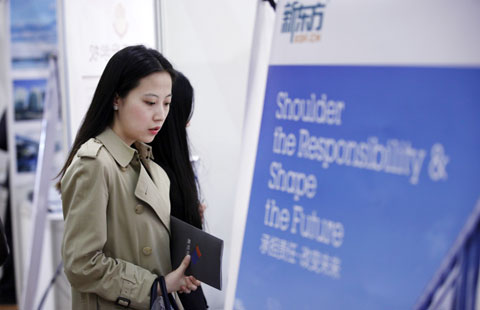China funds new graphene research program in UK
By Cecily Liu (chinadaily.com.cn) Updated: 2016-07-26 19:01Graphene, seen by researchers as the world's thinnest, strongest and most conductive material, could revolutionize aircraft manufacture, and a Chinese funded research program in the UK is now pioneering this process.
The five-year research program announced on Monday is a collaboration between the Beijing Institute of Aeronautical Materials (BIAM) and the National Graphene Institute (NGI) at The University of Manchester, with a goal to help aircraft, high speed trains, and other industrial equipment become simultaneously lighter in weight and more robust in performance.
Traditional manufacturing material would be replaced with graphene, one of the most interesting inventions of modern times. As a thin layer of pure carbon, it is tougher than a diamond, yet very lightweight and easily conducts electricity and heat, researchers say.
More specifically, this research will focus on composites with enhanced performance in the field of mechanical, electric conductive and thermal conductive behaviour, as well as the compatibility of graphene and the matrix materials.
Graphene was first isolated from the graphite mineral at the University of Manchester by Andre Geim and Kostya Novoselov in 2004. The achievement earned them the Nobel Prize for Physics in 2010. Owing to its short history, its commercial potential is yet to be unlocked.
China is now at the forefront of commercializing graphene's applications potential, and has made it a strategically important new material in its 13th Five-Year Plan (2016-20), which sets out the country's development objectives for the period.
China has also been keen to work with the UK on graphene. In October 2015, Chinese President Xi Jinping visited the NGI, during which time the Chinese telecommunications giant Huawei Technologies Corp signed a deal with NGI. In December, BIAM also reached a deal to work with NGI on transport sector graphene research, the success of which led to the larger five year project announced this week.
"We had a very good communication on the first collaborative project. Now a long term partnership would benefit us to broaden the research area on graphene materials, to enhance the collaborative research, as well as to exchange experience and expertise on graphene," said Shaojiu Yan, principal investigator of graphene projects from BIAM.
Robert Young, a professor of polymer science and technology, who leads the project, said the use of graphene in the transport industry could mean significant benefits.
"Graphene is a strong light weight material and in the transport industry it's important to save weight and become fuel efficient," said Young.
Young said China's high technology manufacturing industry, ability to invest heavily into the graphene sector and its abundance of highly qualified graphene industry talents all contribute to its advantages in the graphene industry.
Young said currently one key area of challenge in further commercialization of graphene industry is the lack of universal standards. Currently the NGI and NPL are working towards developing a set of standards applicable and acceptable to the graphene industry, which can then be used to certify quality .
James Baker, Graphene Business Director at the NGI, said cooperation with China grew rapidly since Xi visit in October, and expects it to accelerate.
"The level of interest from Chinese companies keen to work with us has really taken off since the state visit, and we received so many enquiries. We are keen to work with any organizations who have the resources and potential for investment into the graphene industry, so that technology can be commercialized faster," Baker said.
"For the NGI, whilst we are focused on research, we are keen to increase the impact and value that the outcome of our research can bring, therefore working with big industry partners in China can make sense as well as companies from UK and other nations," Baker said.
China's graphene market is estimated to grow to 200 million yuan ($30.7 million) in 2018, compared with the projected global market of $65 million, according to the Beijing-based market intelligence firm ResearchInChina. In comparison, the global market in 2015 was only worth $24.4 million.
To contact the reporter: cecily.liu@mail.chinadailyuk.com
- China backs WHO in implementation of health-related goals: Xi
- China, US vow to boost trust
- Ex-military leader Guo given life in bribery case
- Ministries discuss retirement age, food security
- 'Flying objects' restricted for G20 Summit
- Jobs growing, but applicants are lagging
- Top Chinese economic fugitive to return
- Taiwan investigators detect 'gasoline reaction'
- Government moves to tackle e-waste pollution
- Xi calls for heightened supervision of reform










